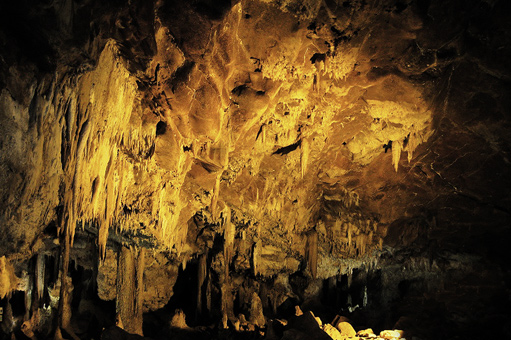 |
 |
Spring Initiation Rites
|
Page 4/5 |
The paintings give a glimpse of eternity between two worlds, the finite and the infinite, the conscious and the unconscious. Put another way, we can see the visions as images of the divine made manifest in animal form. We are reminded of the antique Mithraic mystery cult - like the Eleusinian and Dionysian, the Mithraic mystery cult thrived in Mediterranean countries from ca 700 BC to ca 400 AD - where the bull because of its inordinate, superhuman strength played such a central role. As the super, tutelary animal, the bull here (as in so many other myths) represents the great archetypal symbol for the primordial, eternal forces of creation rolling into time. In the underground mithraic sanctuaries there is always a chamber at the far end of which we find the tauroctony, an image of the god slaying the divine bull. The belief was that the sacrificial death of the bull god would cause the re-birth of nature. I would suggest that the bull-bison paintings of the Palaeolithic temple caves are analogous to the mithraic tauroctony and that they are to be understood as incantations to the bison, the animal divinity who sacrificed his blood and strength to the hunters, to the tribe. By killing and partaking of the bison, man was transformed; he literally and metaphorically transcended his human limitations and became the bison-god.
Bison from the Niaux Cave
Bull from the Lascaux Cave
And staying with the mystery cults of classical times, they were called mystery cults not because they used mystical scripts or doctrines but because their rituals performed in underground sanctuaries promised to give the adept the mysterious, exalted experience of seeing the divine face to face, of becoming deified. As the experience could not be explained rationally, it was a carefully guarded taboo subject. Not much is therefore known of what actually took place during the celebration of the rites in the caves. However, we do have one account in the form of a novel entitled 'The Golden Ass' written by the Roman philosopher Apuleius (b. ca. 130 AD). Here we read:
'I reached the boundary of death, ......and then I returned, carried through all the elements; in the middle of the night I saw the sun blazing with bright light; I approached the gods below and the gods above face to face, and worshipped them from nearby..'
As this passage so graphically illustrates, man's meeting with the divine is a union of opposites. Sometimes referred to as a 'holy marriage', it describes in symbolic language the profoundly psychological experience of the union of man and God for the birth of something new. In the mystery cults it was the miraculous birth of the newly initiated spiritual man that was celebrated, but taken more widely, the conjunction of opposites is understood to mean the birth or resurrection of light out of the confusion and chaos of the night. The paradoxical union of opposites for the birth of something new is taken by many to be the first principle of man's dualistic state in life, in time. In psychology, as in many philosophies and religions, everything that exists has an opposite, a negative, and it is by bringing the two opposites together that the future is born. We witness this archetypal process every day in and around us; we see it also in the eternal wonder of the changes of the seasons when out of the dead of winter the new spring is born. Based on the mystery-motif parallels, we may not be wrong in speculating that a similar archetypal set of ideas informed Palaeolithic man's descent into the dark depths of the cave, and that the rituals performed there were Spring initiation ceremonies devoted to the reconnection with the eternally generative powers for the re-birth of the sun and the animal herds, and thus, for the renewal of the health of the tribe in the year to come.
Descent into the caves
of the Palaeolithic
Man's descent into the
dark depths of the cave
 |
 |
Homo Religioso |
If we subscribe to the shamanistic, that is, to a psychological interpretation of cave art, then the cave-metaphor is a powerful symbol for describing the experience of meeting in time the numinous transformative forces of the unconscious out of time. Such imaginative pictorial images as the Palaeolithic cave paintings and the rituals which they seek to express have not been invented by man but are autochthonous psychological statements arising from the deep activities of the unconscious. As such, they will always remain a mystery - and it is right that this is so. As soon as we try and dissect the Palaeolithic cave paintings and state that they either mean this or that, we have unravelled the precious and complicated weave of strands, and their true meaning is lost: their treasure lies in their totality. Psychologically speaking, the rock paintings of Ice-age man, like the mystery cults, indeed like all the great religious belief systems are not a matter of the intellect but a psychic experience which expresses itself in symbols. The unconscious - because it is unconscious - can only communicate and be communicated in the form of symbols, visions, dreams, and metaphors. The symbolic language of the unconscious is at the same time a most primitive language, arising from the remote, bestial instinctive spheres of our being, and it is also the language which gives man insights of the highest order, far beyond what our rational mind could produce by itself.

Perhaps being human means being homo religiosus - and there has always been a spiritual dimension to human existence. Man has always had intimations of the divine and he has expressed these feelings in rites and ceremonies long before he could think or articulate why or what he was doing. One can try to replace symbols and the religious experience which they carry with science but to do so may be an impoverishment: symbols are like a treasure chest and harbour an immense wealth of age-old insights. Moreover, no science will ever be able to create or replace the archetypal language of man's visions as we find them expressed in the form of the arts. No science will ever be able to explain why we feel entranced by the Palaeolithic cave paintings; why they have the power to move us, address our deepest hopes and fears, and help us to momentarily transcend our human limitations.
Further Reading:
→
Palaeolithic Cave Art and Depth Psychology by Dr. Ilse Vickers
→
Bradshaw Foundation Homepage
→
French Cave Paintings & Rock Art Archive
 Perhaps being human means being homo religiosus - and there has always been a spiritual dimension to human existence. Man has always had intimations of the divine and he has expressed these feelings in rites and ceremonies long before he could think or articulate why or what he was doing. One can try to replace symbols and the religious experience which they carry with science but to do so may be an impoverishment: symbols are like a treasure chest and harbour an immense wealth of age-old insights. Moreover, no science will ever be able to create or replace the archetypal language of man's visions as we find them expressed in the form of the arts. No science will ever be able to explain why we feel entranced by the Palaeolithic cave paintings; why they have the power to move us, address our deepest hopes and fears, and help us to momentarily transcend our human limitations.
Perhaps being human means being homo religiosus - and there has always been a spiritual dimension to human existence. Man has always had intimations of the divine and he has expressed these feelings in rites and ceremonies long before he could think or articulate why or what he was doing. One can try to replace symbols and the religious experience which they carry with science but to do so may be an impoverishment: symbols are like a treasure chest and harbour an immense wealth of age-old insights. Moreover, no science will ever be able to create or replace the archetypal language of man's visions as we find them expressed in the form of the arts. No science will ever be able to explain why we feel entranced by the Palaeolithic cave paintings; why they have the power to move us, address our deepest hopes and fears, and help us to momentarily transcend our human limitations.














